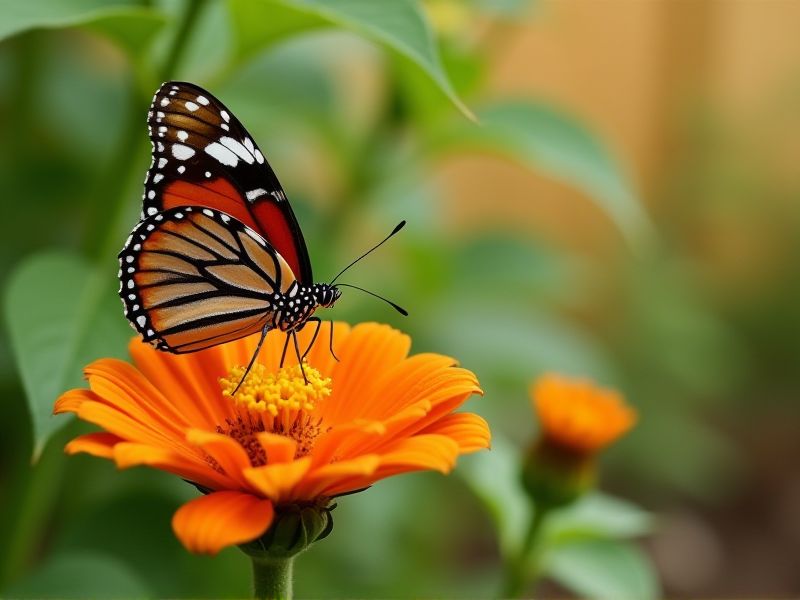
When creating a butterfly-friendly garden, consider incorporating plants like lavender, butterfly bush, and milkweed, which thrive with minimal maintenance. These species not only attract a variety of butterflies but also provide essential nectar sources, fostering pollinator health. Succulents, such as sedum and stonecrop, can serve as supplementary options, requiring infrequent watering and offering habitats for butterfly larvae. Planting native flowers, like coneflower and black-eyed Susan, enhances local biodiversity while ensuring that your garden remains vibrant year-round. By selecting these low-care plants, you can enjoy a flourishing butterfly sanctuary with minimal effort.
List of some Butterfly-friendly plants that require little care
- Coneflower (Echinacea)
- Butterfly Bush (Buddleja)
- Black-eyed Susan (Rudbeckia hirta)
- Milkweed (Asclepias)
- Lavender (Lavandula)
- Salvia (Salvia)
- Joe Pye Weed (Eutrochium purpureum)
- Goldenrod (Solidago)
- Bee Balm (Monarda)
- Lantana (Lantana camara)
Important things about Butterfly-friendly plants that require little care
Native Species Appeal To Local Butterflies.
Butterfly-friendly plants such as milkweed, asters, and black-eyed Susans are native species that thrive in local ecosystems. These plants provide essential nectar for adult butterflies and serve as host plants for caterpillars, fostering a complete lifecycle. They require minimal maintenance and adapt well to various soil types and climates, making them perfect for your garden. By incorporating these native plants, you'll not only attract vibrant butterflies but also support local biodiversity and promote pollinator health.
Drought-Resistant Plants Conserve Water.
Butterfly-friendly plants such as milkweed, coneflower, and asters thrive in dry conditions, making them ideal for low-maintenance gardens. These drought-resistant species not only attract butterflies with their vibrant blooms but also require minimal watering once established. By incorporating these plants into your landscape, you can create a habitat that supports pollinators while conserving water and reducing maintenance time. Consider planting a mix of native wildflowers to enhance biodiversity and provide essential resources for butterflies throughout their life cycle.
Perennials Provide Sustenance For Multiple Seasons.
Choosing butterfly-friendly plants for your garden ensures a vibrant ecosystem while requiring minimal maintenance. Popular options include Butterfly Bush (Buddleja), which attracts various butterfly species with its fragrant flowers, and Milkweed (Asclepias), the essential host plant for Monarch caterpillars. Native flowering plants like Coneflower (Echinacea) and Black-eyed Susan (Rudbeckia) are not only drought-resistant but also offer nectar for adult butterflies. By incorporating these low-care perennials, you can enjoy the beauty of butterflies in your garden while supporting their life cycles effortlessly.
Host Plants Are Essential For Caterpillar Development.
Butterfly-friendly plants such as milkweed, lantana, and aster require minimal maintenance while providing crucial habitats for caterpillars. Milkweed, in particular, serves as the primary food source for monarch caterpillars, making it indispensable for their life cycle. Lantana attracts various butterfly species with its vibrant blooms and is drought-tolerant once established, making it an excellent choice for low-care gardens. By incorporating these plants into your landscape, you not only create a beautiful environment but also support the essential stages of butterfly development.
Flowers With Flat Surfaces Offer Easy Landing For Butterflies.
Butterfly-friendly plants such as coneflowers, black-eyed Susans, and lantanas have flat surfaces that provide a welcoming resting place for butterflies. These low-maintenance perennials thrive in sunny environments, making them perfect for your garden without extensive care. Incorporating these resilient blooms not only beautifies your outdoor space but also attracts various butterfly species, contributing to local biodiversity. By choosing easy-care plants, you create an inviting habitat that supports the essential role butterflies play in pollination.
Brightly Colored Blooms Attract More Butterfly Species.
Butterfly-friendly plants, such as Milkweed, Coneflower, and Zinnia, are excellent choices for creating a vibrant garden that requires minimal maintenance. These hardy perennials thrive in various soil types and sun conditions, making them ideal for busy gardeners. Planting native species is essential, as they provide the necessary habitat and nourishment for butterflies throughout their life cycle. By incorporating these low-care plants into your garden, you can effortlessly support local butterfly populations while enjoying a visually stunning landscape.
Low-Maintenance Plants Save Time And Effort.
Butterfly-friendly plants, such as milkweed and coneflower, not only attract these beautiful insects but also thrive with minimal care. These hardy species require little watering once established, making them ideal for busy gardeners or those new to gardening. Planting varieties like lantana or asters can create vibrant, inviting habitats while also promoting local biodiversity. Embrace the beauty of nature with these low-maintenance options to enhance your garden and support butterfly populations effortlessly.
Minimal Pruning Encourages Natural Growth.
Butterfly-friendly plants like lantana, milkweed, and salvia are excellent choices for gardeners seeking low-maintenance options that attract these pollinators. These plants thrive in various climates and require minimal pruning, allowing you to enjoy vibrant blooms without much effort. By incorporating native species into your garden, you not only support local butterfly populations but also promote biodiversity. If you want your garden to flourish effortlessly, consider adding these hardy plants that provide both beauty and ecological benefits.
Avoiding Pesticides Creates A Safe Habitat.
Butterfly-friendly plants such as milkweed, coneflower, and lantana thrive with minimal care and provide essential nutrients for butterflies. These plants attract various butterfly species, creating a vibrant ecosystem in your garden while also supporting pollinator health. Low-maintenance options like black-eyed Susans and lavender not only enhance your landscape but also offer sanctuary for caterpillars and adult butterflies. By choosing these species, you contribute to a pesticide-free environment that fosters safe habitats for these delicate creatures.
Sunny Locations Enhance Butterfly Activity.
Butterfly-friendly plants thrive in sunny environments and require minimal maintenance, making them ideal for any garden. Species such as lavender, coneflower, and milkweed attract a variety of butterflies while providing habitat and nourishment without demanding excessive care. Incorporating these plants not only supports local butterfly populations but also adds vibrant colors and delightful fragrances to your outdoor space. By selecting drought-resistant varieties, you can create a stunning butterfly garden that flourishes with little effort.
